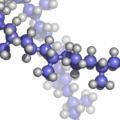Polypropylene
Polypropylene (PP), or polypropene, is a type of plastic. It is a thermoplastic polymer which can be made into a fibre for yarn and fabric, film for packaging, or many other shapes.
| Polypropylene (PP) | |
|---|---|

| |

| |

| |
| IUPAC name | Poly(1-methylethylene)
P |
| Other names | Polypropylene; Polypropene; Polipropene 25 [USAN]; Propene polymers; Propylene polymers; 1-Propene; [-Ch2-Ch(Ch3)-]n |
| Identifiers | |
| CAS number | |
| Properties | |
| Molecular formula | (C3H6)n |
| Density | 0.855 g/cm3, amorphous 0.946 g/cm3, crystalline |
| Melting point |
130 to 171 °C, Expression error: Unrecognized word "to". K, Expression error: Unrecognized word "to". °F |
| Except where noted otherwise, data are given for materials in their standard state (at 25 °C, 100 kPa) | |
As a plastic it can be made translucent but usually is opaque and often brightly colored. It is tough, and resists many solvents, acids and bases.
It can be formed into a thin thread and woven into a strong strap, often used on backpacks, bags, and other things.
In 2008, the global market for polypropylene had a volume of 45.1 million metric tons, which led to a turnover of about $65 billion (€47.4 billion).[1]
Polypropylene Media
Micrograph of polypropylene
Polypropylene lid of a Tic Tac box, with a living hinge and the resin identification code under its flap
Sources
- ↑ "Market Study: Polypropylene". Ceresana Research.









